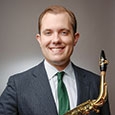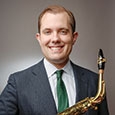In recent years, opportunities for group music-making have grown for students throughout the United States. In larger programs, young musicians can often participate in a percussion ensemble, clarinet choir, flute ensemble, and more, in addition to traditional smaller chamber groups. In some places, these formations operate in the spring months in preparation for solo and ensemble contests. In other locales, these large ensembles have become year-round fixtures. A musical amalgamation with a storied past is starting to reassert itself in the modern era: The saxophone choir is growing in prominence and popularity at colleges and high schools.
I have played in saxophone choirs for many years, originally inspired by my mentor, John Nichol of Central Michigan University, one of the great proponents of such groups. I have formed saxophone choirs in many previous institutions. This summer, to celebrate the return of in-person music making again, I partnered with Jay Wucher, master music educator and Baldwin County (Georgia) Schools Fine Arts Consultant (a fellow saxophone choir aficionado), and Elise Allen (band director at Oak Hill Middle School, Milledgeville, Georgia) for a community saxophone choir for high school students: The Middle Georgia Summer Saxophone Ensemble.
History
The saxophone choir is nearly as old as the instrument itself. Adolphe Sax ran a publishing business along with his instrument manufacturing firm, and printed and sold music for saxophones, saxhorns, and saxotrombas to feed the market for literature for his inventions throughout the 1860s. Along with works for saxophone and piano, composers close to Sax also penned quartets, quintets, sextets, septets, and octets. Jerome Savari was perhaps the most prolific of the composers for these larger forces, and his works for six-to-eight saxophones still serve as light-romantic crowd-pleasers that provide a challenge to talented young performers.
The saxophone choir experienced a huge boost in popularity from the early 1900s through the late 1920s during a time often known as the saxophone craze. American musical instrument manufacturers were eager to find new markets for their wares, and the modern, sleek saxophone was the key to new audiences of amateur musicians. With the advent of jazz bands using the saxophone in the 1920s, the craze became even hotter.
While saxophone virtuosos like Rudy Wiedoeft are often associated with the roaring 20s, amateur, semi-amateur, and professional saxophone choirs were just as prominent. Vaudeville stages in the first quarter of the 20th Century were filled with saxophone ensembles, whose members were often skilled as jugglers, acrobats, comedians, or the like. These groups spawned imitators wherever they went as fraternal organizations, schools, and municipalities sponsored saxophone choirs throughout this period. However, many of these groups, like the saxophone craze itself, folded following the stock market crash of 1929.
The modern pedagogical use of the saxophone ensemble blossomed in the 1940s and 1950s. Percy Grainger, a saxophonist and lover of the instrument, penned a handful of works for septet and octet in these years, and pioneers of the modern concert saxophone used them in their teaching. Larry Teal led an ensemble of his students in Detroit in the 1940s.
Perhaps the most prominent advocate of the saxophone choir in most of the middle of the 20th Century was Sigurd Rascher. The German-American soloist and pedagogue was using the ensembles in his teaching by the 1950s. Soon after, they became part of nearly every workshop and clinic he held. At first, he advocated for transcriptions for saxophone choir, but eventually, he and his students sought out original literature. His students spread the concept of the academic saxophone choir at every college and high school where they subsequently taught.
.jpg)
Rehearsing with The Middle Georgia Summer Saxophone Ensemble, photo by Christie Edwards
A chance encounter further solidified the place of the saxophone choir in modern teaching. A mass ensemble held at a World Saxophone Congress in the 1970s introduced the French master teacher Jean-Marie Londeix to the idea. He soon formed an ensemble with his students at the Bordeaux Conservatory, and from there the idea spread through his many students in France, Japan, Australia, and back to the United States.
Today, many universities sponsor choirs as integral parts of their saxophone studios. Members participate in lessons, quartets, and large ensembles throughout their academic training. It is hard to go to a state MEA conference or the Midwest Clinic today without encountering an excellent example of one of these ensembles.
Many saxophonist band directors have been inspired to start ensembles in their own programs thanks to their exposure to choirs in their training. In the last several years, there appear to be just as many excellent high school saxophone ensembles at the Midwest Clinic as collegiate groups. Slowly, the idea has spread even to directors with no background as saxophonists that groups of saxophones perform with a full, glorious, organ-like tone.
They can also provide great outlets for students in programs with many saxophonists, who often are instructed to play quietly so that they do not drown out other members of the band. A young saxophonist, both in quartets and choirs, can play out and work on a well-developed, beautiful sound. Often, the choir is a great fit for younger players who may not be quite ready for the independent playing required by smaller chamber groups.
Instrumentation
For those thinking about starting a school group, an initial consideration is instrumentation. To date, no true standard exists. Those groups inspired by a French model may consist of twelve members, with three sopranos (with one doubling sopranino), three altos, three tenors, two baritones, and one bass saxophone. Those groups inspired by a Rascher-based model will often be larger, with instrumentation ranging from soprano to bass saxophone.
Directors reading the above may be shaking their heads. The bass saxophone was far more prevalent in the first half of the 20th century. American instrument manufacturers made excellent examples for the time, suggested instrumentation lists, and even advocated for their inclusion in the band into the 1950s. Classics like the Hindemith Symphony in Bb and Grainger’s Lincolnshire Posy call for the instrument. However, with the possible exception of very old high school programs with a long string of pack-rat directors, today’s teachers will be hard-pressed to find a bass saxophone. Indeed, a Selmer Paris bass (the only example currently manufactured by a major brand) costs well over $25,000.
A saxophone choir is more than possible without a bass saxophone, so do not fret. Many pieces are available for more reasonable instrumentations. For those programs with several available altos, at least two tenors, and at least two baris, a wide swath of literature will be playable. If a soprano is handy, the list of available pieces increases even more. For the Middle Georgia Summer Saxophone Ensemble, we kept instrumentation almost exclusively to altos, tenors, and baris. I played soprano on one piece of the program.
Literature
Speaking of instrumentation, it can be intimidating to hunt for high-quality developmental literature. The greatest growth until recently has occurred in the collegiate realm, so much of the available music is quite difficult. However, many excellent, less-difficult publications exist. High school and middle school directors should consider arrangements by Harley Rex, John Nichol, Barbara Bruske, Richard Jensen, and Gary Bricault. While some of their more advanced arrangements may include parts for sopranino or bass, they also have substitute parts that can be played on more common instruments.
There are also many excellent original works by composers Joel Love, Roshanne Etezady, and many more. Saxtet Publications is an excellent source of fun, challenging music. For our program this year, the Middle Georgia Summer Saxophone Ensemble selected Prelude for Eight by Richard Shores; All in Good Time by Karen Street; Shenandoah, arranged by Harley Rex; Owed to the Joy of Sax by Nigel Wood; and National Emblem, arranged by Anderson.
Rehearsing
There are few surprises that occur when first rehearsing these ensembles. The early practices should include the reading of chorales, such as John Nichol’s transcriptions of Bach favor-ites, or Jean-Marie Londeix’s exercises for saxophone choirs (Exercises pratiques pour ensemble de saxophones). This will encourage students to play out in a way that they may not be used to in a band and will develop good approaches to balance and intonation.
Speaking of balance, for nearly any arrangement or original composition playable by high school ensembles, doubling of parts is acceptable, and even desired. However, avoid doubling alto parts in saxophone choirs without beefing up the corresponding lower sections. Saxophones are slightly less able to project than low brass, so balance can go a bit askew if this is not considered.
I hope these words of advice will inspire many more directors to form saxophone ensembles (or encourage students to form them) in their programs. The choir is a wonderful opportunity for music making that can inspire young saxophonists as little else can. The sound is beyond compare: majestic and rich like a great organ. Don’t take my word for it – hear it for yourself.






